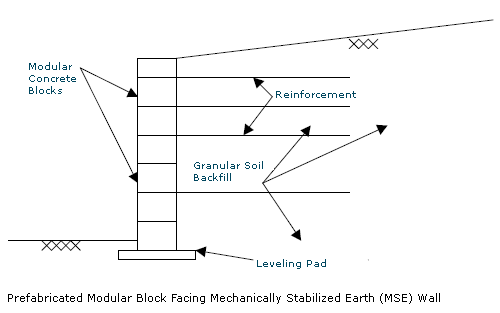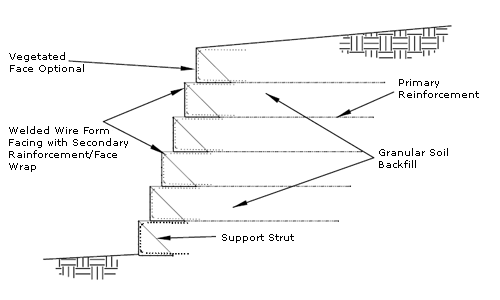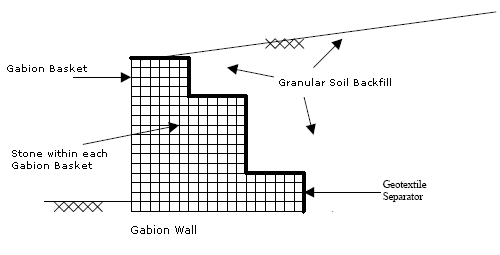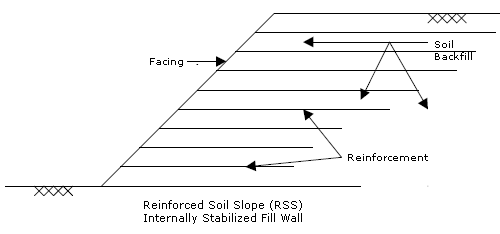Dry or wet cast, this modular concrete block facing wall consists of vertically stacked, concrete blocks in which geogrid, metallic grid or geotextile reinforcement is secured between the blocks at predetermined levels. The reinforcement extends from the blocks into a granular soil backfill. Each layer of the backfill consists of one or more compacted lifts. The reinforcement may be connected to the wall face through friction developed between vertically adjacent blocks or through the use of special connectors.
Panel Facing
This wall employs metallic (mat, geogrid or geotextile) reinforcement that is connected to a precast concrete or prefabricated metal facing panel to create a reinforced soil mass. The reinforcement is placed in horizontal layers between successive layers of granular soil backfill. Each layer of backfill consists of one or more compaced lifts. A free draining, nonplastic backfill soil is required to ensure adequate performance of the wall system.
Wire Form Facing
This mechanically stabilized earth wall uses “L” shaped wire forms stacked upon each other with an incremental setback as its facing. Geo-grid reinforcement is strategically located between designated forms and is extended back into the granular soil backfill. Each layer of backfill consists of one or more compacted lifts. A secondary reinforcement wrap is used at the inside face of the form to add strength to the face as well as to contain the granular backfill. The facing of a welded wire form wall can also be constructed with a vegetated face providing a softer, greener, aesthetically pleasing look.
Gravity Wall
Rock or vegetated face, these walls are compartmented units filled with stone and are typically termed tailed gabions. Each unit is a rectangular basket made of galvanized steel, geosynthetic grid or polyvinylchloride (PVC) coated wire. Each unit is laced together on site and filled with select stone. These walls can be designed with wire mesh or geosynthetic reinforcement that extends back into the retained soil from between the unit.
Reinforced Slopes
These earth retaining systems incorporate planar reinforcement, typically geotextile or geogrid, in constructed earth slopes with face inclinations of less than 70 degrees. The reinforcement is laid down alternatively with horizontal layers of compacted soil backfill. Each layer of backfill consists of one or more compaced lifts. If slope facing is used to prevent erosion or provide a desired appearance, the facing may be constructed by: 1) extending reinforcement layers outside the slope face and wrapping each layer around the overlying backfill and then reembedding the free end into the backfill; or 2) extending reinforcement to slope face and then either vegetating the face or placing erosion control mats or prefabricated elements against the slope face.
Natural Stone Facing
This mechanically stabilized earth wall uses stacked “natural looking” stones as its facing. Geo-grid or geo-textile reinforcement is secured between the stones and is extended back into the granular soil backfill. Each layer of backfill consists of one or more compacted lifts.
During construction there are many factors that affect the loading on a retaining wall. Following are a few one should be aware of:
- Types of backfill
- Drainage of backfill material
- Backfill overloads (heavy equipment)
- Placement of backfill
- Type of material beneath footing





